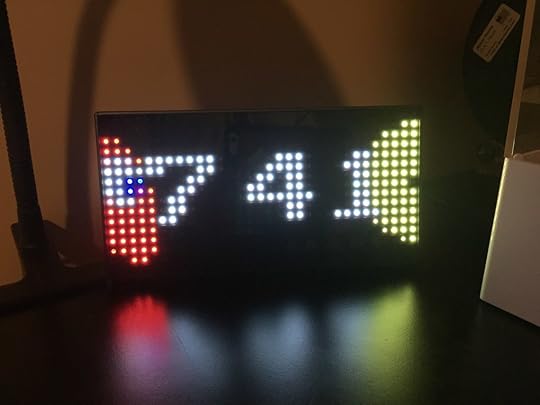Bill Loguidice's Blog, page 95
February 6, 2017
Review: HyperX Alloy FPS Mechanical Gaming Keyboard
Having enjoyed the use of modern mechanical keyboards in the past decade or so, including the Gigabyte Aivia Osmium Mechanical Gaming Keyboard (with Cherry MX Red Switches), ROCCAT RYOS MK Pro Mechanical Gaming Keyboard (with Cherry MX Blue Switches), and Logitech G710+ Mechanical Gaming Keyboard (with Cherry MX Brown switches), among many others, I’ve become quite the advocate for premium keyboards of this type. Outside of portable computing, which is presently served by a Microsoft Surface Pro 3, I practically insist on using a mechanical keyboard. While gaming responsiveness is certainly a factor, I do tons of typing, which is why the solid feel and quick action of a good mechanical keyboard is so important to me.

The front of the box.
While my personal holy grail – yet to be met – is a wireless, backlit, mechanical keyboard with a tenkey (number) pad, I believe I’ve found the next best thing in the HyperX Alloy FPS Mechanical Gaming Keyboard. My current standing desk at home has a lot going on with its top surface, including two lights, a 3D printer, Surface Pro 3 dock, XRGB-mini, AverMedia Live Gamer Portable, and an ultra widescreen monitor, in addition to my keyboard, wireless trackball, various knick knacks, and a small workspace for books, magazines, or notepads to reference. As such, I was looking for a way to supplant my effective, but bulky, ROCCAT RYOS MK Pro, which has a permanently attached, and thick, braided USB cable. Basically, there was no easy way with my current setup to place that keyboard to one side when I needed more desk space. With no suitable wireless options available, the compact HyperX Alloy, complete with detachable, braided USB cable, seemed like a great alternative. I can just detach the miniUSBcable from the back of the keyboard when I need more space, and plug it back in when I need it again. Simple.

The back of the box.
Here are the HyperX Alloy’s key features:
Cherry MX Blue switches, which are ideal for typing
Compact design with a solid-steel frame
Detachable miniUSB cable
Red backlit keys
USB charging port (if a second USB port is used on the computer end of the USB cable)
Full anti-ghosting and N-key rollover support (basically lets you press as many keys as you want at the same time)
While there are no dedicated media or other specialized keys, nor software for things like backlight and other customization, you can still control media functions and cycle through six preset LED modes for the backlighting (including “off,” of course, and keys you specify) with simple key combinations. For all the fancy keyboards (and related) that I’ve bought over the years, I rarely, if ever, used the customization software (other than maybe a one button press to bring up something like Notepad++ or the calculator), and I rarely, if ever, changed my lighting preferences, including when fancy RGB light shows were available. In that regard, I absolutely don’t miss any of that here.

How it fits on my desk.
In the package you get the keyboard itself, mesh travel pouch, USB cable, and various paperwork. You also get a keycap puller and optional textured, red keycaps to replace the usual gaming-centric A, W, S, D, 1, 2, 3, and 4 keys.
The important part of course is how this all works. Fortunately, even though there’s the usual small user learning/comfort curve that comes with almost any new keyboard design (and particularly one that’s fairly radical like this one), it works great. Keypresses provide suitable physical and audible feedback, and I’m able to type at full speed without issue. My gaming tests proved just as successful. While compact, there are no sacrifices to key size, and the steel structure provides plenty of weight.
If you’re like me and want a no sacrifice, yet compact mechanical keyboard with removable USB cable, then the HyperX Alloy makes a fine choice. In fact, I may not even need that personal holy grail solution. As such, I’m happy to award the HyperX Alloy FPS Mechanical Gaming Keyboard our first Editor’s Choice award for 2017.

2017 Armchair Arcade Editor’s Choice Award
Pluses:
Cherry MX Blue switches
Well-built and compactly designed, with no sacrifices to key sizes
Removable miniUSB cable
Easily transportable, complete with travel pouch
Red backlighting is generally less distracting than other types (and can be disabled)
Minuses:
Limited customization options and no dedicated software
The post Review: HyperX Alloy FPS Mechanical Gaming Keyboard appeared first on Armchair Arcade.
January 22, 2017
Book review: Invisible World by Oksana Mazur
 After previously reviewing and liking the Levenhuk Rainbow 50L Biological Microscope, it was a no-brainer to agree to review Invisible World by Oksana Mazur (2006, but updated through 2016), which is part of the So far, so near series by Levenhuk Press. The title page gives the full title, “Marvelous and amazing journeys with a microscope into the INVISIBLE WORLD discovered 350 years ago by Antonie van Leeuwenhoek, a Dutch textile merchant, naturalist and scientist.” The book is for children of primary and secondary school ages 6+.
After previously reviewing and liking the Levenhuk Rainbow 50L Biological Microscope, it was a no-brainer to agree to review Invisible World by Oksana Mazur (2006, but updated through 2016), which is part of the So far, so near series by Levenhuk Press. The title page gives the full title, “Marvelous and amazing journeys with a microscope into the INVISIBLE WORLD discovered 350 years ago by Antonie van Leeuwenhoek, a Dutch textile merchant, naturalist and scientist.” The book is for children of primary and secondary school ages 6+.
The 95-page book comes as a nice square hardcover with 10 inch sides. It features a full color, densely packed layout, with oversized text throughout. Each page is packed with information, images, and interesting asides. The book’s basic structure covers the history of the microscope, different types of microscopes, working with microscopes, and various categories and descriptions of observable objects like drops of water, seeds, starches, insects, and hair. Suggestions for hands-on experiments help to round out the primary content.

The content is colorful and packed with information.
In the back of the book is advertorial content describing Levenhuk and Bresser microscopes, telescopes, slide sets, binoculars, and more. While this would normally be considered bad form in an educational text, it’s admittedly interesting to see some real world options available for purchase. As my two oldest daughters, ages 10 and 12, will attest, this is a fascinating book. And even if you’re a bit out of the suggest age range, there’s still a lot to like here.
Pluses:
Hardcover
Content-packed, full color layout
Comprehensive
Minuses:
Advertorial content in the back of the book
The post Book review: Invisible World by Oksana Mazur appeared first on Armchair Arcade.
January 20, 2017
Nintendo Switch, 4K or bust, no apps, and other thoughts
As part of our ongoing series of editorials on the Nintendo Switch leading up to its launch, today I bring up a few more points of interest/discussion for the intriguing new platform.
First up, Amazon has a great price ($69.57) on a 200GB microSD card that should work well for the Nintendo Switch. That’s a big boost over its onboard 32GB, which of course is a bit less thanks to the necessary storage of system and other files.
Next up is the speculation that, when docked, the Nintendo Switch might be 4K capable because of previous Tegra-powered devices having the capability. Unfortunately, there’s zero to indicate that Nintendo has made it 4K capable. It’s a huge assumption that it would be possible to do 4K with the dock since it’s not like 1080p-capable devices can output 4K by default, while we know that 1080p is definitely supported thanks to Nintendo’s own words. Again, if it were possible, even theoretically, there would be zero reason for them not to state it to at least have marketing parity with the competition.
For another, this whole no non-gaming apps at launch thing makes me wonder if Nintendo doesn’t want to pay the licensing/engineering fees to Netflix, Amazon, YouTube, et al., in case the Switch struggles. This way they don’t have to cancel support in the future. I mean, it’s not absolutely critical that they have non-gaming apps at launch, but it’s a curious omission in this day and age when seemingly every other device has them as little more than a side effect of modern technology. It’s nice to have the option, and, from a psychological standpoint, the more time you spend with one device over another, the better. If the Switch is just used for gaming and not media streaming (which again, is a completely natural use case for a portable device that can also dock to a TV), that’s definitely an excuse to use other devices for when you don’t want to game. Nintendo needs to make the Switch a favorite portable device, so, the more use it gets, the more likely that is to happen. Of course, Nintendo specifically stated they didn’t rule it out for the future, so there’s that, but it’s still not something a betting man would have expected to be lacking for launch.
Finally, the other curious thing is Nintendo seemingly wanting to handle most of the social and online aspects of the Switch via Smartphone app (we already know there’s no Miiverse for the Switch). That in and of itself may point to the lack of desire to have anything on the Switch other than games. Again, a curious strategy in light of the way things traditionally work. As we know, though, Nintendo always moves to the beat of their own drum, for better and worse. Hopefully for them and the future of the Switch, this is not the latter situation.
The post Nintendo Switch, 4K or bust, no apps, and other thoughts appeared first on Armchair Arcade.
January 18, 2017
Nintendo Switch Sales Predictions
Nintendo has a lot riding on the success of the Nintendo Switch. After dominating in sales for the first half of the Nintendo Wii‘s existence, Nintendo’s console ambitions have, for a variety of reasons, been in decline, culminating in the ultimate failure of the Wii’s follow-up, the Wii U. Similarly, while Nintendo reached unprecedented sales heights with the DS handheld series, sales of its follow-up series, 3DS, although ultimately a success, have paled in comparison to previous Nintendo handhelds in the face of consumers turning ever more to their smartphones (and, to a lesser degree, tablets). So where does leave the hybrid Switch?
The Switch needs to create its own relative niche and thrive from there. While I have agreed and continue to agree that, despite Nintendo’s protests, this is indeed the successor to the Wii U and 3DS, the latter, dedicated mobile gaming, is not necessarily a potential growth market (in fact, just the opposite). With that said, if it even sold only half as much as the 3DS series, that alone would get it to at least 30 million units, which would get the Switch to Nintendo 64 levels of sales. Perhaps add in Wii U-like console sales performance, and that gets us to over 40 million units sold. That’s still about 10 million units less than the PS4has sold in a little over 3 years, but a bit more than the Xbox One has sold in roughly the same amount of time. That’s probably good enough for a viable third place (the aforementioned thriving relative niche) for the Switch, especially if sales levels remain reasonably consistent on the way to that number.
We know that the PS4 initially sold well in its first year or so mostly on promise rather than compelling content, and that Xbox One sales were initially retarded my Microsoft bungling the marketing message and holdover from their original intentions for the console that they eventually fully reversed course on, etc. Both companies have respectively recovered from said deficiencies and continue to thrive, including with an incremental upgrade console plan that has seen little consumer backlash and positions them well for continued future sales. In terms of the Switch, Nintendo has a content issue, and it looks like the usual major third parties are taking a mostly wait-and-see approach, so they’d need some of that PS4 magic and initially sell as much on promise as on content (keeping in mind, Zelda, Splatoon, Mario, etc., will help, and that’s something Sony didn’t really have). And a la Microsoft, they’ll have to carefully manage their marketing message and change course when necessary, e.g., Nintendo presently promising a subscription online Switch service with suspect value.
So, what are my thoughts? While I’m a supporter of the concept (and buyer of the actual Switch system), I do fear Wii U-like ennui from buyers, particularly if, like previous Nintendo consoles, third party software support seriously lags. The Switch concept is wonderfully versatile, but the big question is will the average consumer think it’s wonderful, especially in regards to the portable nature of the unit. In other words, does the average consumer really want a portable device that’s not their smartphone (or, sometimes, their tablet)? I’m not necessarily convinced they do, but hope that I’m wrong. If I’m not wrong, then we’ll have another Wii U on our hands, and who knows where Nintendo can go from there, at least when it comes to the traditional videogame market.
The post Nintendo Switch Sales Predictions appeared first on Armchair Arcade.
January 17, 2017
News: The Minstrel’s Legend – Persistent World RPG in Development for Mattel Intellivision!
Intv Prime is developing an amazing looking RPG for the Mattel Intellivision (Wikipedia, book; console first released in 1979), called The Minstrel’s Legend (TML). Formally announced in September 2016, it should see release this year (thanks to Indie Retro News for the heads-up). The game is described as “a one-player ‘sword and sorcery’ open world role-playing video game.” Set in an Earth-like planet in fantasy medieval times, the object is for a small group of adventurers to renew the imprisonment of the demon Xcitticx by playing a magical song. The song is written on parchment that was torn into thirds – one piece is in an overrun fort, another in an abandoned mine, and the last is in Xcitticx’s temple itself. If they cannot succeed in a few days, the demon will escape and the game will be lost.

The Minstrel’s Legend
TML is said to be one of the few games for the Intellivison that features a persistent world, where changes to the game world are stored and kept. Limits on equipment and abilities last throughout the game, areas that are left will have the same state when revisited, and events that occur in the beginning will make a difference at the end. Sounds great and should be a fun cartridge release when it’s finally available!
Full description from the official Website follows:
The game mechanics are similar to those used in the early Ultima series, Nethack, and tabletop role-playing games. Movement, decisions, and combat are turn-based. The terrain of the continent does not change, rewarding repeat players that remember the tricks of navigation, but the location of the fort, mine, and temple changes with each game, and the layout of each one is programmatically generated. The player’s party begins with four apprentice-level characters, having various statistics (strength, intelligence, agility, fortitude, luck) and skill sets that require them to work together to complete the mission.
Calio, the minstrel. He leads the group and the only one that can play the song to re-imprison the demon and win the game.
Gruk, the warrior. His skills as a hand-to-hand fighter are critical to protecting the rest of the party from enemies.
Pelia, the ruid. Her healing talents are important to keeping the party alive during the adventure.
Tloju, the wizard. His spellcasting ability is crucial to obtaining pieces of the song parchment that Calio must play.
The characters start with minimal equipment, but can acquire new items and treasure by defeating enemies in battle. Treasure can be traded at a safe outpost for new/additional items.
As wandering monsters and enemies the guard the parchment pieces are defeated, the characters will gain experience. Increased experience improves character fighting ability, spell quantity and power.
The player must balance the need to find all parchment pieces to re-imprison Xcitticx, the need for characters to rest (to heal and renew spell and song abilities), and the need to strengthen the party through battles.
The post News: The Minstrel’s Legend – Persistent World RPG in Development for Mattel Intellivision! appeared first on Armchair Arcade.
January 16, 2017
Outstanding Questions for Nintendo and the Nintendo Switch
I’ve talked a lot about the Nintendo Switch in the past year or so, and most recently after the official Switch presentation (here and here). While a lot of questions were answered, several more remain outstanding. Here’s a summary of the key questions that we’ll hopefully see answers to prior to the March 3, 2017 release date:
Question 1 – Digital Purchases
Will Nintendo finally tie game purchases to accounts rather than systems? That would give them parity with Sony and Microsoft in this regard and would make people like me buy a lot more digital games on a Nintendo system than we have in the past. That would also make it easier and more logical to own multiple Switch systems.
Question 2 – Resolution and Performance
We know that 720/30 (i.e., a resolution of 1280×720 at 30 frames per second) is the norm when in handheld mode, but will 1080/60 (1920×1200 at 60 fps) be the norm when docked? We’re already getting reports of potentially 1080/30 and even resolutions of 900p (1600×900). Obviously 4K support is out, but having some assurance of what the minimum docked resolution and frame rate is expected to be would be a nice technical detail to know.
Question 3 – Value-add for Online Subscription
Since Nintendo is now going to charge for a “premium” online system, what exactly will the value-adds be? Both Sony and Microsoft offer several “free” games for multiple of their platforms a month that you get to keep as long as you maintain a subscription. It seems that Nintendo’s current answer is that you get to rent a single Virtual Console game (NES and SNES have been mentioned) with added online functionality for the month, but you don’t get to keep it after that, even if you maintain your subscription (you do of course have the option to purchase it outright). Unless the associated discounts are significant, I’m really searching for a value-add here, particularly since there’s every reason to be skeptical that Nintendo will be able to pull off the same type of network/ecosystem as the competition.
Question 4 – Software Support
It’s a question that has dogged Nintendo for generations now, but are there any significant third party titles in the works for the Switch? It seems that Nintendo’s first announced AAA title (outside of the launch Zelda game that is also being released on Wii U) is going to be Super Mario Odyssey, but that doesn’t come out until later this year. What third party titles will be filling the first party gaps? NBA 2K18 is a quality annual sports title and Elder Scrolls V: Skyrim is a durable, if oversaturated, modern day classic, but is anything really new and significant on the horizon? Right now, that answer is no, with no present indication from major third parties that anything might be on the way. This could turn out to be a real problem for the Switch, just like it was for its Wii U predecessor.
Do you have more questions for Nintendo and the Switch? Let me know in the comments.
The post Outstanding Questions for Nintendo and the Nintendo Switch appeared first on Armchair Arcade.
January 13, 2017
Third Party Nintendo Switch Accessories Already Available
Filed under “that was fast,” third party accessories for the Nintendo Switch are already starting to be posted. This particular batch of accessories is from PowerA.
Nintendo Switch Joy-Con Comfort Grip – Red
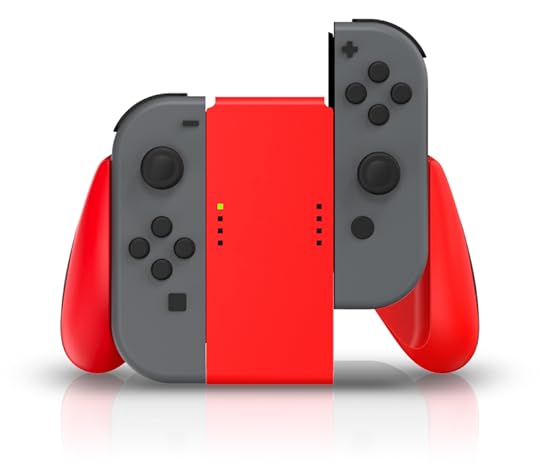
Nintendo Switch Joy-Con Comfort Grip – Red
Marketing blurb:
If you love Nintendo Switch, you’re going to spend a lot of time playing it. The Comfort Grip brings the left and right Joy-Con Controllers together to make one comfortable controller, so you can play as long as you like. Ergonomic, rubber grips will keep your palms happy and your fingers from cramping at home or on-the-go. Simply slide each Joy-Con Controller down the rails until they click, and view the player indicator lights through the front. ProTip: the Comfort Grip stands up on its own and looks great next to your Nintendo Switch Dock.
• Lightweight, ergonomic design for comfortable gameplay anywhere
• Double-injected rubber grips for added comfort
• Easy slide-in design secures each Joy-Con
• Visible player indicator lights
• Available in black or red
Nintendo Switch Joy-Con Charging Dock

Nintendo Switch Joy-Con Charging Dock
Marketing blurb:
The Joy-Con Charging Dock is the easiest solution for charging your Nintendo Switch Joy-Con Controllers. Charge 4 Joy-Con Controllers at a time for multiple players, or keep an extra pair charged for single players to switch out. Simply slide the Joy-Con Controllers down and wait until each charge LED turns green!
• Charges up to 4 Joy-Con Controllers simultaneously
• Individual LEDs indicate charge level for each Joy-Con
• Easy slide-in design connects each Joy-Con to charger
• Weighted base for stability
• Powered via USB
Nintendo Switch Hybrid Cover
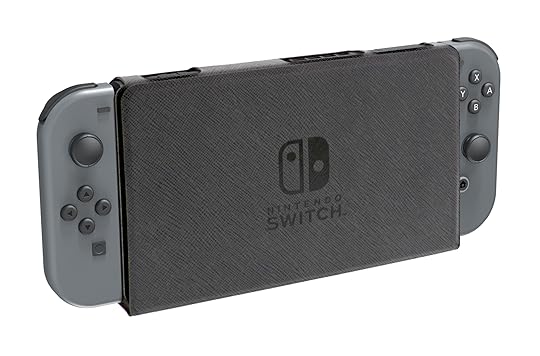
Nintendo Switch Hybrid Cover
Marketing blurb:
The Hybrid Cover is a must have for taking Nintendo Switch on-the-go. The wrap-around design features hidden Velcro and a magnetic closure to keep the Switch Console secure, by itself or with Joy-Con Controllers attached. Open the cover and display the Switch Console in 3 different viewing angles during tabletop mode, wherever you go. Includes a screen protector and cleaning cloth.
• High-quality cover with magnetic closure keeps the Nintendo Switch secure
• Multiple viewing angles for playing and watching in tabletop mode
• Includes a Screen Protector and Cleaning Cloth
Nintendo Switch Everywhere Messenger Bag
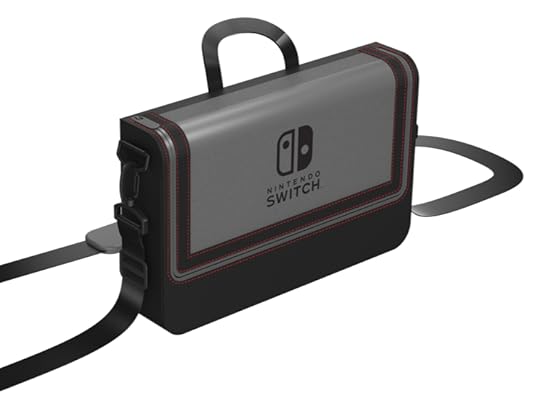
Nintendo Switch Everywhere Messenger Bag
Marketing blurb:
The Everywhere Messenger Bag stores the complete Nintendo Switch system for easy portability, and features a removable internal case for carrying the Nintendo Switch handheld style. Design, security, and comfort make this bag a must-have for the Nintendo Switch gamer on-the-go. This bag is officially licensed by the Nintendo Switch team, so you can game however you like, wherever you like.
• Stores the complete Nintendo Switch System for easy portability
• 2-in-1 design with removable internal case that carries Nintendo Switch for handheld mode
• Fitted compartments keep all components secure
• Adjustable shoulder strap with padding for added comfort
The post Third Party Nintendo Switch Accessories Already Available appeared first on Armchair Arcade.
Nintendo Switch Presentation and Places to Pre-order
Nintendo had their long-awaited Switch presentation last night and revealed additional details about a platform that is expected to be the company’s sole combined console and handheld gaming strategy going forward. Perhaps most important, though, is that that presentation also kicked off pre-order opportunities in the US at Amazon, Best Buy, Target (where I ended up ordering my grey system and Mario Kart and Zelda games from after several false starts), and GameStop, for its March 3, 2017 release date. MSRP, which shouldn’t budge until at least 2018, is set at $299.99 (which pretty much falls in line with my earlier prediction, although I was expecting a few different SKUs instead of just the one, although it is available in grey or blue/red neon styling).
What follows, are the system’s key details. What I find most interesting is that it fits our prediction of 720p resolution and about 3 hours of battery life when used as a handheld. Neither is especially great, but are good enough for the first iteration of this product. Finally, here’s a list of the games, plus what looks like Nintendo actually trying to take their classically weak account systems and online services to a level at least somewhat similar to what Sony and Microsoft are doing, including having a premium tier with a subscription fee.
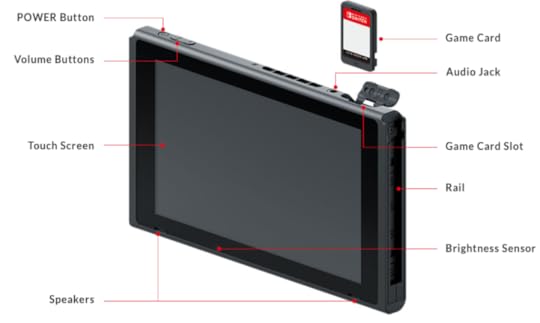
Nintendo Switch Front

Nintendo Switch Rear

Nintendo Switch Dock

Joy-Con Controllers Front
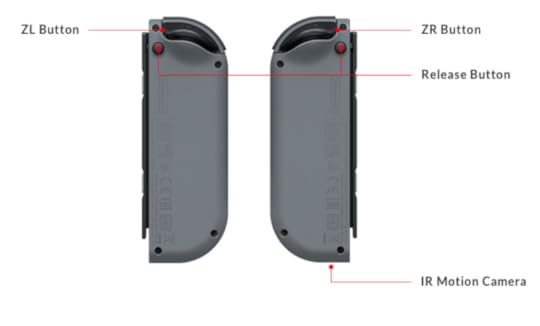
Joy-Con Controllers Rear

Joy-Con Controllers Side

Joy-Con Grip Front

Joy-Con Grip Rear

Joy-Con Strap Front

Joy-Con Strap Side
The post Nintendo Switch Presentation and Places to Pre-order appeared first on Armchair Arcade.
December 30, 2016
Review: Pac-Man Premium LED Desk Clock and Infinite Dungeon Corridor
Today, I’m taking a quick look at two nifty products for the gamer in your life, even if that gamer is you. The first is the Raw Thrills Pac-Man Premium LED Desk Clock, and the second is the ThinkGeek Infinite Dungeon Corridor desktop toy.
Pac-Man Premium LED Desk Clock
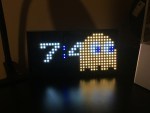 The Pac-Man Premium LED Desk Clock is officially licensed from Bandai Namco Entertainment, Inc., and provides a vibrant color LED display in a plastic case that’s about 7.5 inches across. It’s AC powered, so requires an outlet, and also requires a manual clock set. Once that’s done, the time is displayed in white LED numbers with a flashing blue seconds divider. Occasionally, an animated Pac-Man sequence runs across the numbers. Although there’s no sound, the look and overall smoothness is really nice.
The Pac-Man Premium LED Desk Clock is officially licensed from Bandai Namco Entertainment, Inc., and provides a vibrant color LED display in a plastic case that’s about 7.5 inches across. It’s AC powered, so requires an outlet, and also requires a manual clock set. Once that’s done, the time is displayed in white LED numbers with a flashing blue seconds divider. Occasionally, an animated Pac-Man sequence runs across the numbers. Although there’s no sound, the look and overall smoothness is really nice.
A video posted by Bill Loguidice (@bill_loguidice) on Dec 30, 2016 at 7:59am PST
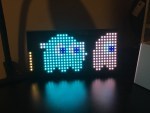 While I really love the clock, it’s not without its flaws. For one, there are no sound options, even though there’s a speaker cut-out on the back of the case. For another, this is strictly a desktop option. Because of the backing platform, there’s no real ability to hang this on the wall. Of course, its small size and cord type would make such an option difficult. And finally, the display is extremely bright. It would be nice to have a few brightness and other options for the display.
While I really love the clock, it’s not without its flaws. For one, there are no sound options, even though there’s a speaker cut-out on the back of the case. For another, this is strictly a desktop option. Because of the backing platform, there’s no real ability to hang this on the wall. Of course, its small size and cord type would make such an option difficult. And finally, the display is extremely bright. It would be nice to have a few brightness and other options for the display.
Pluses:
Vibrant color display
Authentic visuals and animation
Straightforward
Minuses:
Pricey
Only one brightness level (just a notch below “looking directly at the sun”)
No sound effects
Not wall mountable
ThinkGeek Infinite Dungeon Corridor
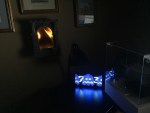 The ThinkGeek Infinite Dungeon Corridor is a battery powered desktop or wall mountable optical illusion. It’s about 3 inches deep and just over 6 inches wide, with a height of approximately 9.5 inches. Three AA batteries, not included, power it. When you want to turn it on, simply flip the switch. Once on, the torch lights flicker convincingly, and, thanks to the discrete mirror backing, appear to go on forever. Of course, the darker the room, the better the effect, since it cuts down on outside reflections.
The ThinkGeek Infinite Dungeon Corridor is a battery powered desktop or wall mountable optical illusion. It’s about 3 inches deep and just over 6 inches wide, with a height of approximately 9.5 inches. Three AA batteries, not included, power it. When you want to turn it on, simply flip the switch. Once on, the torch lights flicker convincingly, and, thanks to the discrete mirror backing, appear to go on forever. Of course, the darker the room, the better the effect, since it cuts down on outside reflections.
Infinite Dungeon illusion. It looks far better in person.
A video posted by Bill Loguidice (@bill_loguidice) on Dec 15, 2016 at 6:29pm PST
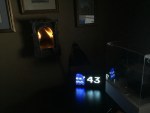 Much like the Pac-Man clock, I really love this optical illusion desktop toy, but it too is not quite perfect. The plastic window is really reflective outside of the darkest of rooms and there’s no option to power this with an AC adapter for longer term use. Finally, when not looking at this straight on, the backing does look every bit of plastic cheesiness from the side.
Much like the Pac-Man clock, I really love this optical illusion desktop toy, but it too is not quite perfect. The plastic window is really reflective outside of the darkest of rooms and there’s no option to power this with an AC adapter for longer term use. Finally, when not looking at this straight on, the backing does look every bit of plastic cheesiness from the side.
Pluses:
Effective illusion with a well-matched theme
Runs on AA batteries
Minuses:
Pricey
Batteries are not included
Plastic window is extremely reflective of outside sources
The exterior casing looks a bit cheesy and plasticky when not viewed straight on
No AC power option
The post Review: Pac-Man Premium LED Desk Clock and Infinite Dungeon Corridor appeared first on Armchair Arcade.
December 2, 2016
Review: Atari Flashback Portable (AtGames, 2016 version) (includes videos)
AtGames has released the Atari Flashback Portable, which is now available from a variety of major US retailers. While list price is $59.99, typical retail price is often quite a bit less.
The Flashback Portable is part of the new AtGames Flashback Zone, which encompasses an increasing number of retro-themed products and a new social media presence on both Twitter and Facebook. The AtGames Flashback Zone is expected to be the AtGames retro gaming portal going forward and should hopefully see regular expansion. Other products for this year include: Atari Flashback 7, Sega Genesis Classic Game Console, Sega Genesis Ultimate Portable Game Player, and Atari Flashback Classics Volume 1 and Volume 2 for Sony’s PlayStation 4 and Microsoft’s Xbox One.
What you get
In the box you get the handheld itself, a miniUSB cable for charging, and instructions. The handheld measures approximately 5.5 inches across, 2.5 inches high, and about three quarters of an inch deep.
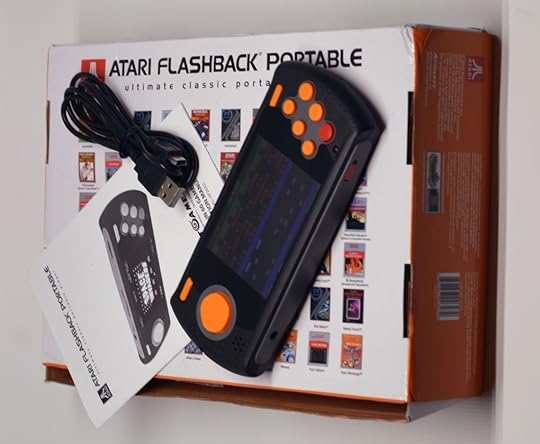
The box and its contents. Note that this is the limited pre-release review version, and the actual wide release version has a different built-in game list (e.g., no new Space Invaders port or Jungle Hunt).
How it works
As expected, the Atari Flashback Portable is basically a handheld version of the Atari Flashback 7 console, just like the Sega Genesis Ultimate Portable Game Player is a handheld version of the Sega Genesis Classic Game Console. Although the Flashback Portable sports a newer generation of the hardware powering Flashback 7, there is no noticeable difference in the already excellent quality of the emulation.

Page 1 from the manual, showing what each of the buttons and other hardware functions do.
Unlike the Atari Flashback 7, there are enough buttons on the portable to replicate the original Atari 2600‘s six switches, as well as provide for extra features like returning to the Main Menu and pausing games. Naturally, the biggest difference between the portable and console is that the former sports an oft-requested SD card slot to play your own game ROMs. More on that later.
In terms of the game selection menu (aka, Main Menu), a push to the left or right on the joystick moves to the previous or next page, respectively, while up and down moves amongst the games on the same page. The primary action button (A) selects the highlighted game.
Once a game is selected, the game is started the same way as on the original console, which usually means pressing Start/Reset or the A key (main fire button). Once in a game, you can select the usual difficulty (L, R) and game mode (S) options, as well as TV Type (T). An onscreen display lets you know when player 1 or player 2 difficulty switches are set to hard, although it’s unfortunate that it remains on the bottom of the screen outside of the play area once active. Since TV Type is an auto return switch type, pressing that button only displays Mono on the bottom of the screen outside of the play area momentarily.
Although officially undocumented, a diagnostic menu option was publicly reported, so I’m able to repeat that useful info here. Hold down the three largest buttons (A, R, and S) when turning the unit ON and you’ll get a RAM, sound, and button check. This is useful if for some reason you suspect that something might be wrong with your unit, although most problems are usually related to a weak battery charge or not charging the unit long enough.
Games
You can see the full list of 60 games here (remember, my pre-production review unit and a limited number of early release units have a different list of 60 games). Basically, they’re a mix of first and third party titles, along with some homebrews (Frogger is a new port specific to the 2016 Flashback hardware). Although there is no hardware paddle option, the built-in emulator automatically lets you use the d-pad to play paddle games.
Here are some of the built-in games in action, recorded using the optional composite TV out cable (note that the Atari Flashback 7 review shows other games in action, which perform the same here):
Dark Cavern
Star Strike
Video Pinball
More games using the SD card slot
Since this is a dedicated handheld, the unit only supports single player games that make use of the original console’s left joystick port. This means oddball games like Basketball or Wizard of Wor that make player one use the right joystick port don’t work the way they’re supposed to (look out for hacks that helpfully reverse the ports! (refer to this AtariAge thread on needed controller hacks for games)). Games that use special controllers, like Star Raiders or Cookie Monster Munch, also will not work without some type of hack (one exception, the one original Driving Controller game, Indy 500, works just fine via the portable’s d-pad). Everything else, including the aforementioned paddle-based games, has a chance of working.
To add your own games, acquire an SD card that’s 8GB in size or smaller, and add your .BIN format ROMs to a root folder called Game. Most ROMs should appear without issue as long as they are in the correct format: the first initial should be a capital letter, followed by all lowercase letters. For example, Spaceinv.BIN will work, but SPACEINVADER.BIN will not.
Of special note, AtariAge user thevnaguy has also posted his impressions of a similar pre-production model and AtariAge user Flojomo (working along with thevnaguy and others) has taken it upon himself to post a shared Atari Flashback Portable Compatibility List to keep track of what works and what doesn’t via SD card from the Atari 2600’s large original library (a growing number of hacks and homebrews are also being included on the spreadsheet).
Although some notable games, like Berzerk and Galaxian don’t work without glitches (perhaps hacked versions will eventually appear that will work), and dozens more don’t work at all, many hundreds of titles work perfectly. Considering SD card support is a secondary feature outside of the 60 built-in games, that’s not too bad.
Here are some examples of SD card-based games in action:
Space Invaders (Atari)
Pac-Man 4K (homebrew)
Frogger (Parker Brothers)
Audio/Video
The built-in LCD has good brightness and color (remember to remove the clear plastic shipping cover on the screen!), and no motion blur. It does a good job of displaying the low resolution content. There’s a single speaker, but you can plug in headphones for added audio punch.
There is also a composite AV connection, which allows you to connect to an external display with an optional cable, and is how I was able to capture the videos. When you plug in the cable, the internal screen goes off and the picture and sound are sent to the TV.
As you would expect, the composite connection is just about the poorest connection available, but also arguably the most universally compatible, especially with the type of older CRT TVs the Atari 2600 games were originally intended for. It’s best to use the AV output of this portable with one of those older TVs as video quality will vary dramatically on modern displays, although is still generally usable. Of course, when using this on a modern display, you’ll want to make sure the games are shown in their original 4:3 format (like in the portable’s own native aspect ratio) rather than 16:9 (widescreen), although that’s more of a pet peeve of mine than a strict requirement.
Conclusion
The Atari Flashback Portable is probably as close to perfect as AtGames has gotten with any of its hardware to date. It uses the proven handheld design from their long-lived Sega Genesis Ultimate Portable Game Player series and makes the tweaks necessary to give it a proper Atari 2600-centric identity. Hopefully for next year’s version we’ll see further improvements in the user interface and overall game compatibility from the SD card. For now, this year’s version fills a glaring hole in the AtGames hardware line-up and is well worth the relatively low price of entry.
Pluses:
Nice screen
Headphone jack
Solid game selection
SD card slot to add your own games
Composite AV TV output option for legacy displays
Minuses:
Persistent onscreen Hard difficulty display status can be distracting
Limits on game compatibility through the SD card slot
Playing paddle games with the d-pad is not ideal
Thanks to AtGames for providing the review unit.
DISCLOSURE STATEMENT: I advise AtGames as an Independent Contractor. Of particular note in relation to this specific review, I provided design and feature guidance for the hardware, including button layout. I also provided design feedback and play testing for Frogger throughout its development. Opinions expressed in this review are solely my own, however, with no external consideration or approval.
The post Review: Atari Flashback Portable (AtGames, 2016 version) (includes videos) appeared first on Armchair Arcade.

